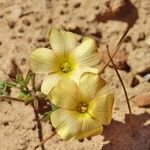A rather lax plant, usually 5-15 cm high. Bulb oval with attenuate points at the base and apex, often fusiform, with hard blackish-brown tunics, deeply pitted and irregularly angled, glabrous or rarely sparsely pilose with simple and short capitate hairs. Rhizome short, rarely up to 10 cm long, producing bulbils freely in the axils of the scales. Stem either not exserted, forming a short stipe or, particularly in shade and mountain forms, elongated to 10 cm or more long, leafless, slender, always pilose with soft reversed hairs. Leaves 10-20, rarely up to 60, basal or congested at the apex of the stem, or very rarely imbricating on a short stipe; petioles 2-4 cm long or longer in shade forms, articulated to a scale-like and sometimes pseudo-stipulate base, pilose with soft reversed hairs, or very rarely with patent, ascending or short glandular-capitate hairs; leaflets 3 or 5, shortly petiolulate, 0.5-2.5 cm long, obcordate, cuneate-obcordate or oblong-obcordate, sometimes triangular in outline, bilobed to the middle, often heterophyllous, the early leaflets obcordate, the later elongating to narrow-cuneate or linear emarginate, varying from closely silky-pubescent on both faces to entirely glabrous, more or less impresso-punctate when dried, variously callus-dotted or ecallose, occasionally purplish beneath and rarely purple-mottled above. Peduncles about twice as long as the leaves, softly pilose with reversed hairs, rarely with short capitate hairs admixed; bracts 2, opposite, at an articulation above the middle. Sepals oblong or oblong-lanceolate, obtuse or subacute, 1/3 to 1/4 the length of the corolla, softly pilose with ascending hairs, always with some reversed hairs at the base, ciliate, ecallose or very rarely with apical calli. Corolla 1.5-2.5 cm, usually about 2 cm long, pink, brick red or palish yellow; tube short, more or less widely or rarely narrowly funnel-shaped, yellow; petals subcuneate, with variable attenuation into a short claw, obliquely sub-truncate at the apex, glabrous or very rarely pilose near the outer margin, often purple-veined beneath. Filaments often glandular-pubescent, the longer either edentate, gibbose or even with teeth over 1 mm long, the longest (or styles) well exserted from the corolla tube. Ovary pubescent on the upper part, ecallose, the chambers many-ovuled; styles usually with simple and short capitate hairs admixed. Capsule oblong, not or scarcely exserted beyond the calyx. Seeds endospermous. Sometimes producing double flowers.
More
Perennial herb with stems developed only when plants growing in shade; bulb ovoid, often fusiform, 5–15 mm long, deeply pitted and irregularly angled, tunics tough, reddish-to blackish-brown; bulbils formed in axils of scales along rhizome. Indumentum of simple, eglandular hairs except for glandular hairs on filaments or simple capitate hairs on the style. Stipules inconspicuous, to c. 1.5 mm long, membranous, abruptly tapering into petiole. Leaves basal, 3-(rarely 5-) foliolate; petiole 1.5–5.5 cm long, sparsely hairy; leaflets subsessile, variable, often dimorphic, obcordate to linear-emarginate, 4–10 (–25) mm long, 3–7(–25) mm wide, shallowly bilobed (sinus to one-eighth leaflet length), green, sometimes purplish below, glabrous to pubescent on both faces, margins ciliate, lobe apices rounded apices and 2–5 (–12) mm apart. Inflorescences basal, 1-flowered; peduncles 2–14.5 cm long, to twice as long as the leaves, sparsely hairy with retrorse hairs. Bracts situated in the upper half to one-fifth of pedicel length, narrow-subulate, 2–4 mm long, with ascending, antrorse hairs, calli absent. Sepals oblong to oblong-lanceolate, 4–8 mm long, glabrous to pilose, base with some retrorse hairs, margins ciliate and often red, rarely with apical calli. Petals subcuneate, 10–15 (–25) mm long, pale yellow or pale orange-fawn with fine dark red veins, greenish at the base, glabrous (or very rarely pilose near the outer margin). Stamens at 2 levels; filaments often glandular-pubescent, the longer set either edentate, gibbose or toothed. Ovary pubescent on the upper part. Styles usually with simple and short capitate hairs admixed. Capsules not developed in Australia.
Acaulescent or rarely caulescent geophyte, 50-150 mm tall, with recurved hairs on petioles and peduncles. Bulb tunics hard, deeply pitted, blackish brown. Leaves basal or apically congested, leaflets 3 or rarely 5, obcordate, narrow-cuneate to rarely linear, hairy,± callus-dotted. Flowers 1 per peduncle with opposite bracts above middle, pink, brick-red, yellow or white, with darker veins and a yellow tube, petals rarely pilose on outer margin.
Acaulescent geophyte with deeply pitted bulb. Leaves trifoliolate, leaflets cuneate-obcordate, hairy. Flowers pink, brick-red, yellow or white, with darker veins and yellow tube, peduncle articulated.
Possibly originally a garden escape, collected from Melbourne suburbs Reservoir, Eltham and South Yarra. In Reservoir it is naturalised in the Central Creek Grasslands in Themeda triandra-dominated grassland on basalt-derived soil. It is also naturalised at Buckley Falls in the Geelong area where growing in a Themeda triandra community, and at Betley in north-central Victoria, where abundant in an Avena crop, as well as along roadside, and also invading Eucalyptus leucoxylon and E. microcarpa woodland.
More
It is a subtropical plant.

